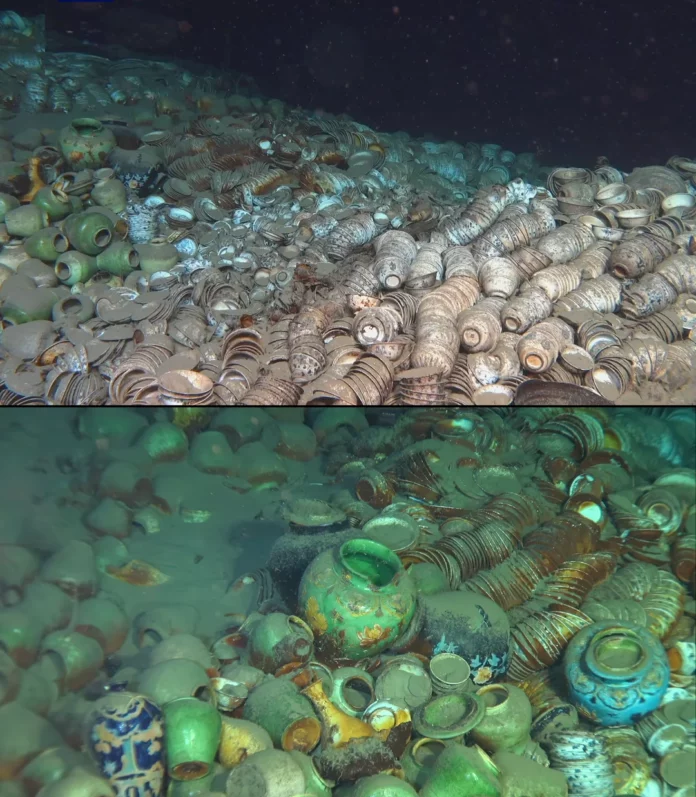In an unprecedented underwater archaeological discovery, researchers have uncovered two ancient shipwrecks from the Ming Dynasty (1368-1644) at a depth of 1,500 meters in the South China Sea. This finding, announced by the National Cultural Heritage Administration on May 21 in Sanya, Hainan province, marks a significant milestone in the study of ancient Chinese maritime history and the Maritime Silk Road.
Discovery of the Shipwrecks
A team from the Chinese Academy of Sciences’ Institute of Deep-sea Science and Engineering located the shipwrecks on a continental slope in October. Named the “Northwest Continental Slope No. 1 and No. 2 Shipwrecks in the South China Sea,” these sites represent China’s first deep-sea ancient shipwreck discovery of this magnitude.
Preliminary Investigations and Findings

Shipwreck No. 1
According to Yan Yalin, director of the archaeology department at the National Cultural Heritage Administration, the No. 1 shipwreck spans an area of approximately 10,000 square meters. The site is believed to contain over 100,000 cultural relics, primarily porcelain items. Most of the ship remains buried under sand, with some sections concealed by up to 3 meters of relics.
Shipwreck No. 2
Located about 20 kilometers from the No. 1 site, the No. 2 shipwreck revealed several processed logs of wood and a small number of ceramic items. Based on the analysis of salvaged porcelain relics, the No. 1 shipwreck likely dates back to the reign of Emperor Zhengde (1506-1521), while the No. 2 shipwreck dates to the reign of Emperor Hongzhi (1488-1505).
Historical Significance

Yan Yalin emphasized the historical, scientific, and artistic value of the well-preserved relics, calling it a potential world-class archaeological discovery. The findings offer key evidence of the ancient Maritime Silk Road, providing significant insights into historical Chinese overseas trade, navigation, and porcelain production.
Key Porcelain Production Hubs
Items from Jingdezhen in Jiangxi province and the Longquan Kiln in present-day Zhejiang province, both crucial porcelain production and export centers in ancient China, dominated the relics found near the No. 1 shipwreck. A video released by the research team showcased a variety of items, including blue-and-white porcelain, celadon pottery, and green-glazed ceramic wares.
Understanding Ancient Trade

The logs found on the No. 2 shipwreck suggest import trade activities, as ancient Chinese documents record timber as an imported item. Tang Wei, director of the National Centre for Archaeology, noted that these discoveries provide key references for understanding historical trade route changes across the South China Sea. The presence of both inbound and outbound ships in the same area highlights the significance of this maritime route for reciprocal trade flows.
Ongoing Research and Future Plans

Protection and Monitoring
To protect the relics, the exact coordinates of the shipwrecks have not been disclosed. A metal surveying marker was placed near the No. 1 shipwreck to aid future research. The investigation, involving about 30 experts from various institutions, officially began on May 21 and will continue through June. The submersible Shenhai Yongshi (Deep Sea Warrior), carried by the research vessel Tansuo 1, facilitated the underwater exploration.
Advanced Technologies
Chen Chuanxu, a scientist at the Institute of Deep-sea Science and Engineering, highlighted the use of advanced technologies, including soft robotics inspired by bionics, new scanning methods, photography, and real-time monitoring. These innovations are crucial for salvaging relics and understanding the site’s condition.
Future Expeditions
Song Jianzhong, a researcher at the National Centre for Archaeology, stated that around 50 dives are planned between now and April 2024. These expeditions will assess the shipwrecks’ conditions and draft archaeological excavation and conservation plans. Future missions will also include geophysical and geological studies, as well as marine life research.
Conclusion
The discovery of the Ming Dynasty shipwrecks in the South China Sea represents a groundbreaking achievement in underwater archaeology. This finding not only enriches our understanding of ancient Chinese maritime history but also highlights the importance of the Maritime Silk Road. With continued research and advanced technology, these shipwrecks promise to reveal more about historical trade, navigation, and cultural exchanges between ancient civilizations.
